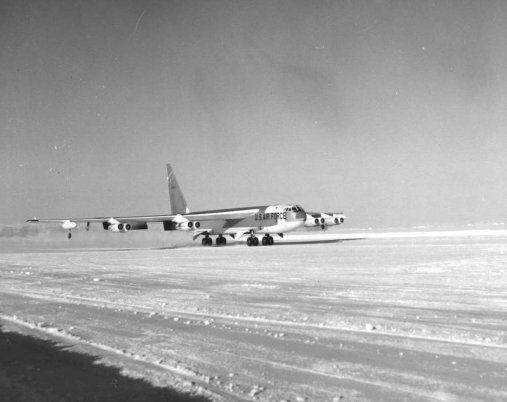Let me take you back to an Arctic night in January 1968, still the era of the Cold War. An American B-52 bomber gets into trouble, the crew scramble to safety and the plane comes down in Greenland with an enormous amount of weapons-grade plutonium on board. Residents of Greenland working at the American base in Thule immediately set out across the ice with husky teams to get to the downed plane – the Americans desperate to get there before anyone else.”
These were the words spoken to the European Parliament in 2007 by Diana Wallis, a British MEP. It sounds like a promising plot for an international blockbuster movie, but this largely forgotten piece of history not only had serious ramifications for the unfortunate workers commissioned to clean up the radioactive debris, but also uncovered clandestine nuclear activity on Danish soil, despite the nuclear-free zone peacetime policy announced by Denmark in 1957.
Trouble at the top stays at the top
Perched right at the top of the globe, Thule Air Base has been of enormous strategic importance to the US since its construction in the early 1950s. It’s an ideal location for radar to scan the skies for any stray incoming missiles. What the Danish populace did not know or need to know at the time was that, since 1961, nuclear-armed B-52 bombers had been continuously circling Thule Air Base on routine ‘hard head’ missions, as part of a cold war strategic missile warning system. Not only that, but around 50 nuclear weapons had also been stored at the base between 1958 and 1965.
It was on one of these routine missions on 21 January 1968 that a fire broke out in the cockpit of a B-52 stratofortress. The pilot, Captain John Haug, gave the mayday signal, and the plane, loaded with four nuclear warheads, was abandoned to crash into the ice of Greenland. The husky rescue teams set off and the rest is history, although had it not been for the unrelenting detective work of Aarhus radio journalist Poul Brink almost two decades later, it would have remained in the footnotes.
 Brink thinks he can spy a link
Brink thinks he can spy a link
One summer’s day in 1986, Brink got a tip-off to investigate a story about a Thule worker, Ruben Eriksen. Eriksen claimed that he had fallen ill with lymph cancer as a direct consequence of clearing away plutonium-contaminated snow following the plane crash. Brink made the journey to Risø Research Centre, which was responsible for the testing of the Thule workers at the time.
He was wholly unconvinced by the evidence of the scientists, an episode he describes in detail in his book ‘Thule-Sagen – Løgnens Universe’ (Thulegate – A universe of lies). The scientists strongly hinted that alcoholism caused by the lonely working environment at Thule Air Base was the cause of the high death rate. Brink noted that he found the evidence “just as polluted as the snow the Thule workers had removed”.
He said as much on national radio and at the same time appealed for other workers to come forward. The phone didn’t stop ringing over the following days: Thulegate was born and Brink pieced together the story. It was a journalist’s dream, containing classic elements such as secret documents, hidden agreements between Denmark and the United States, prime ministers who were economical with the truth and, ultimately, an innocent group of people who were caught up in the politics of denial.
State responds … 28 years later
It took a great deal of detective work and research from Brink to provoke the authorities into action. In the summer of 1995, the government were pressurised into opening investigations. The then foreign minister, Niels Helveg Petersen, declared confidently at a press conference on 29 June 1995: “I am glad to note that … there were no atomic weapons in Greenland.” Just two weeks later, a flustered Petersen revealed in a dramatic turnaround that around 50 nuclear weapons had, after all, made their way to Thule Air Base.
This was a source of huge embarrassment for the government and had been prompted by the unearthing of the infamous 18 November 1957 letter from Prime Minister HC Hansen to the American ambassador. In this historic document, Hansen referred to the possibility of storing “supplies of munitions of a special kind”, noting that the US government “did not see any problem in this matter”. The prime minister of Denmark, no less, had tacitly given the USA carte blanche to store weapons at Thule Air Base. Denmark’s non-nuclear policy had lasted less than a year.
 A settlement but no liability
A settlement but no liability
With the case at last capturing the imagination of the general public, Prime Minister Poul Nyrup Rasmussen commissioned a radiological examination of the surviving workers. The conclusion was that even though cancer incidents were 40 percent higher among the clean-up workers than the other workers at the base before and after the operation, it could not be concluded that radiation exposure was to blame.
In 1987, around 200 former workers from 1968 had taken legal action against the United States. Despite being unsuccessful, the action resulted in a mountain of hitherto unreleased and classified documentation for Brink to wade through. In 1995, the Danish government paid 1,700 workers compensation of 50,000 kroner each – a payment that many of the workers regarded as a lump sum intended to buy their unconditional silence. Officially the payment was an ex-gratia payment and in no way an admission of any liability.
Brink received an award for his sterling journalistic work in 1997 and survived a year-long government enquiry into his role acquiring confidential documents. He died suddenly in 2002 at the age of 49, but the case was still far from closed.
Broken arrow alert … somebody tell Spectre
In 2000, media reports that Thule workers claimed to have evidence of an unexploded and unrecovered bomb were largely ignored. However, in 2008 a BBC documentary brought the case to the international stage by providing strong evidence from a number of sources to reveal that investigators at the time could only account for three out of the four weapons. Was there still an unexploded nuclear weapon on the seabed at Thule?
In April 1968, a fruitless submarine seabed search for the lost bomb had taken place with Danish authorities blissfully unaware. According to BBC journalist Gordon Carrera, one document from July 1968 reads: “Fact that this operation includes search for object or missing weapon part is to be treated as confidential NOFORN.” The code NOFORN means not to be disclosed to any foreign country.
Despite this compelling evidence from the BBC, the Danish Institute of International Studies (DIIS) released a 279-page report in August 2009 to address the speculation about the missing bomb. It was not open to misinterpretation and intended as a clear message to shut down the case for once and for all: “There is no bomb, there was no bomb and they were not looking for a bomb.”
 Cagey about upsetting the US
Cagey about upsetting the US
The government, then led by Anders Fogh Rasmussen, were equally dismissive of any long-term health impact on the workers. Kaare Ulbak from the Danish National Institute of Radiation Protection stated unequivocally in the 2008 report on radiation levels in Thule: “The total radiation dose for representative persons in the Thule area for plutonium contamination resulting from the 1968 Thule accident is lower than the recommended reference level, even under extreme conditions and situations.”
Thule workers strongly disagree with this contention. In the aftermath of the crash, Thule worker Jens Zinglersen mounted the search and led the rescue of the crew with native dog sledge teams, receiving an Air Force Exceptional Civilian Service Medal for his efforts. Zinglersen went on to become the head of the Thule Workers Association and has led the struggle to reveal what the organisation sees as the truth.
In an interview with the BBC in 2008, Zinglersen said: “I think it’s a cover-up. We are getting older and the Danish authorities and the Danish government will wait and keep their mouths sealed for another 15, 20 years; then there’s no-one left who remembers and who was a part of the accident back in the days of ‘68.”
In 2008, the Thule workers took the case to the European courts. They claimed that Denmark, in contravention of both a European court directive from 2000 and a European Parliament resolution in 2007, had failed to monitor their health with regular check-ups, leading to delays in detecting illness. The USA have monitored and continue to monitor their workers, but to this date Denmark has refused to co-operate. The health of Danish and Greenlandic workers involved in the clearing up of radioactive ice continues to be unmonitored.
Not yet dead and buried
It is now 45 years since the B-52 spectacularly careered out of control into the ice, but for those living in the region now, and those who worked at the base then, the incident is far from dead and buried. The political scandals may have died down, the official reports may have published their dismissive conclusions, but the fact of the matter is that many of the workers from 1968 are now dead – and many of them from cancer-related illnesses. With regular medical monitoring, the lives of many of the workers could have been improved by the detection of the cancer at an earlier stage. The Thule case appears to be closed, but history has shown that it has a habit of resurfacing – as perhaps the mythical lost bomb at the bottom of the ocean may yet do one day.














